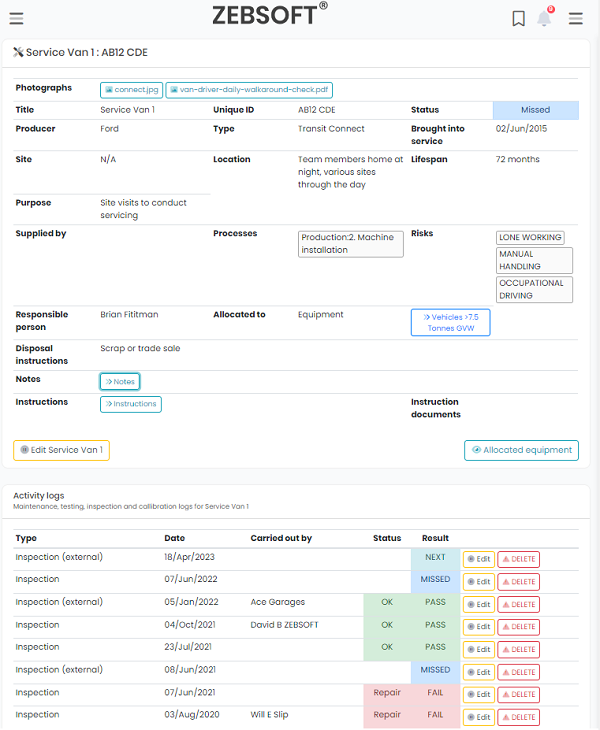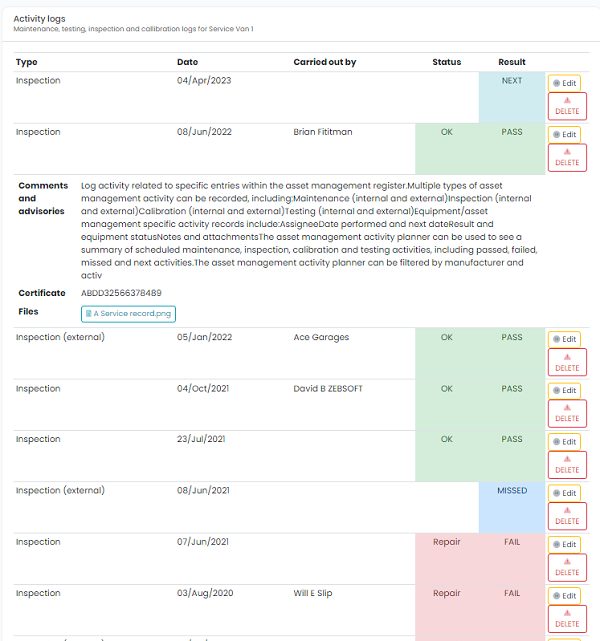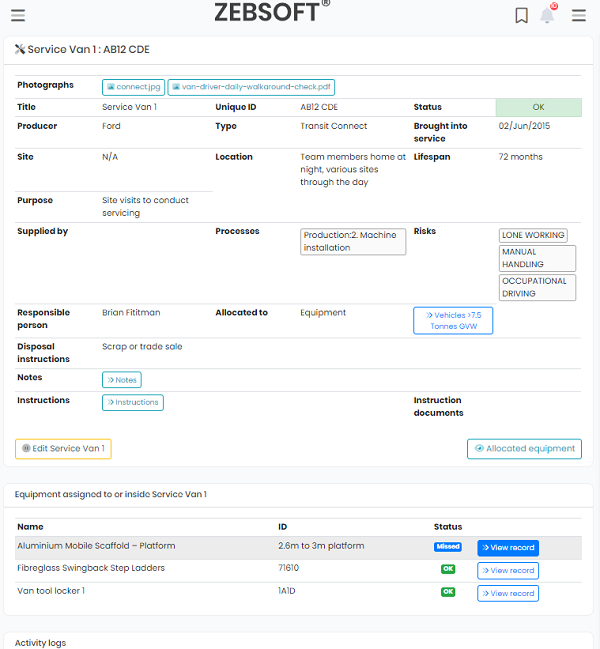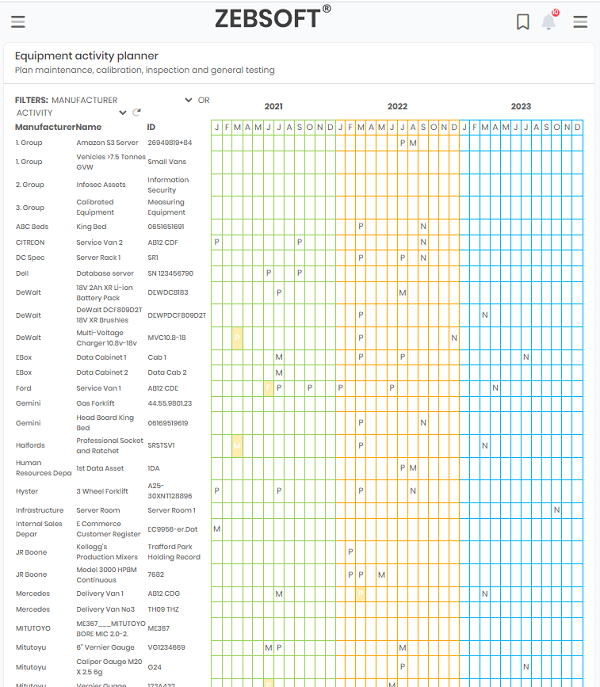Universal Asset & Equipment Management System Software

Create a comprehensive asset record
- Current status
- Linking of Risks, Processes, People & Suppliers
- Unique IDs
- Producer / Manufacturer
- Types
- Locations
- Purposes
- Brought into service dates
- Lifespans
- Disposal date and instructions
- Condition monitoring photos
- Responsible person
- Allocation of other equipment
- Usage instructions
- Important Notes


Asset records contain a complete historical activity log
- Log activity related to specific entries within the asset management register.
- Multiple types of asset management activity can be recorded, including:
- Maintenance (internal and external)
- Inspection (internal and external)
- Calibration (internal and external)
- Testing (internal and external)
- Equipment/asset management specific activity records include:
- Assignee
- Date performed and next date
- Result and equipment status
- Notes and attachments
- The asset management activity planner can be used to see a summary of scheduled maintenance, inspection, calibration and testing activities, including passed, failed, missed and next activities.
- The asset management activity planner can be filtered by manufacturer and activity type.
Associate assets
- Suppliers of products & services
- Processes in which they are used
- Risks specific to them


Asset management activity planning
- See asset status easily
- A direct route to the asset record
- View planned activities up to 3 years ahead
- Create assets groups and drill down through many levels
Whatever it is you wish to manage ZEBSOFT has the functionality you need, to achieve effective maintenance and inspection activities.
- Calibrated instruments and equipment
- Data & Information Assets
- Fleet Assets
- Properties and Facilities
- Software and Applications
- Equipment and Machinery
- IT Hardware
- Infrastructure Assets
The ZEBSOFT Asset Management Software is a complete platform to enable you mange a full lifecycle, with its full management information system features, assets and lifecycles can be aligned to your environmental and health and safety activities.
Attain comprehensive & insightful information about the asset management systems that can be used to achieve unbroken productivity.
What is Asset Management Software?
It’s a cloud-based software tool to track and manage your business assets. Allowing organisations to manage all their assets in one solution. It can be used for software, hardware, equipment, and tools.
Asset Management Software allows your organisation to manage life cycle. Handling data from asset purchase to final disposal. You can create mobile asset registers and plan your preventive maintenance. As well as improving your inventory management.
Asset Management Software, computerised software system used by businesses to improve the management and tracking of assets. Allowing asset managers, a detailed asset register. Storing all asset data in centrally thus reducing the need for spreadsheets with limited control capability.
An asset management system allows companies to manage and store data on multiple assets. Specifically those essential to the company’s day-to-day operations and revenue generation our complete and easy to use platform provides many benefits, including:
- Maximises Life Cycle Management
- Increased asset visibility in the workplace with real-time tracking
- Extends the useful life of profit-critical assets
- Accurate asset registers
- Reduces the costs associated with purchasing and maintenance
- Ensures health and safety, and overall compliance
Numerous features of ZEBSOFT Asset Management Software contribute to better asset life cycle management. You can track your fleet, IT equipment, and physical assets. enabling asset managers to keep track of an asset’s stages of useful life. include preparation, acquisition, upkeep, use, and disposal. An asset register is then used to store, monitor, and access data. An asset management system’s typical features enable users to:
Real-time tracking and asset management
Attaching tags and labels enables the tracking of physical objects. Barcodes, RFID, QR, NFC, and GPS trackers are a few of them. Each asset tag offers unique advantages and works well in various tracking scenarios. Businesses can maintain track of their assets by using asset tags. being aware of their location and their users Whether it be inventory in warehouses or computer equipment in offices. Aside from the purchase history and maintenance schedules of an asset.
Schedule and plan for preventive maintenance
Businesses need to carefully plan maintenance methods in order to maintain their assets functioning at their best. Maintenance managers can collect information on a variety of parameters by keeping an eye on the asset life cycle. such is an asset’s lifespan, condition, maintenance, and breakdowns. A schedule for preventive maintenance is then created using this data. allowing businesses to schedule the upkeep of mission-critical assets. This lowers the possibility of unscheduled downtime and enhances the condition of the assets. Additionally, maintenance and downtime costs are decreased.
Build a Detailed Asset Register
Asset Management Software provides the tools to build an accurate asset register. An asset register consists of various data that helps to make better-informed decisions. Particularly when it comes to purchasing, maintenance, and operation. Asset registers include real-time locations, purchase information, and maintenance plans. As well as depreciation values. They’re available to users on desktops as well as mobiles, via a cloud-based app. Allowing them to be accessed at any time, whether in the office or in the field. As opposed to using spreadsheets, which can be error-prone and time-consuming.
Utilize a mobile device to access data
Users can access data at any time and from any location with mobile access. Whether they are maintenance engineers, asset managers, or field operators. A mobile app can be used to access an asset management system via a mobile device. It enables users to access asset registers off-site to inspect, amend, and add to them. Data can also be updated while in motion on devices having barcode and QR code scanners built in.
Following and observing asset life cycle management
Asset management requires a strategic and analytical approach, which can only be achieved with the aid of asset management software. Businesses may make better judgments on the four essential stages of by having access to this data.
tracking and monitoring asset life cycle management
Improve Inventory Management
Although asset management tracks equipment a business uses, it also monitors inventory levels. Asset Management Software can be set up to track inventory that moves in and out warehouses. Whether that be part of a supply chain or stock in a warehouse. Thanks to IoT-enabled tools and tracking technology such as Barcodes. All inventory data is stored on a shared system. Providing greater visibility to all users. With this information, firms may make better decisions about the planning, acquisition, use and maintenance, and disposal phases of an asset’s life cycle. It informs firms when an asset is performing at its best. Moreover, maintenance can raise asset reliability.
The Advantages of Asset Management Software in Businesses with Lots of Assets
Asset management is the process of organising and overseeing a company’s full inventory of assets. including purchasing, using, caring for, and discarding. A number of aspects go into the management of assets, both tangible and intangible. All aid in keeping tabs on and tracing the most crucial and financially dependent assets of a company. Whether they be structures, machines, cars, or IT technology.
Businesses can automate their asset management procedures with asset management software. This has a number of cost-saving advantages. such as improved operations and productivity. Additionally, you’ll be able to buy things with superior knowledge. The following advantages further emphasise the significance of asset management:
Determine the Asset Depreciation Value.
It is simpler for firms to comprehend the worth of their assets thanks to asset management software. Planning and buying are the first steps in asset assessment. The value of an asset during its useful life is the next topic covered. until the asset’s useful life is over and it has a final value. The depreciation value of an asset is determined by comparing its purchase price to its utilised value. Asset managers are able to make wiser financial judgments when they are aware of an asset’s depreciation value. Additionally, it increases the accuracy of an organization’s record-keeping.
Calculate the overall cost of ownership (TCO)
Understanding the total cost of ownership for an asset is directly related to depreciation value. TCO is a technique for identifying the most valuable assets.
Cut back on unplanned downtime
Being able to automate data collecting is a crucial component of asset management software. including necessary maintenance information Businesses can utilise this information to determine overall usage, projected usable life, and maintenance expenses. enabling asset managers to approach maintenance and repairs in a proactive manner. compared to paying up to 10 times as much for repairs if an asset is operated until it fails. Without a preventive maintenance strategy, businesses run the danger of unscheduled downtime. causing critical equipment failures that could hurt sales. Businesses can lose hundreds of thousands in revenue per hour on average due to unplanned downtime.
Who Uses and Needs Asset Management Software?
Asset management software offers a variety of functions for monitoring and tracking corporate assets. It can therefore be used in a variety of industries and procedures.
Building, Facilities, and Property Management
Property, facilities, or buildings comprise 5 to 20% of total asset costs. Therefore, being able to handle property assets effectively can be beneficial. Businesses can keep track of the costs of depreciation, appreciation, and acquisition prices.
Property and facility upkeep must be considered in addition to the budgetary demand. Additionally to cleaning, visitor tracking, security control, and energy management. These operations can be planned, noted down, and reported on with the use of an asset management system. A framework can be offered by a contemporary property management technology to:
- Create and keep an asset register.
- Do an appreciation and depreciation calculation.
- Plan, follow, and keep an eye on maintenance tasks
- Cleaning up the records
- Control workplace design
- For safety and security, monitor guests and residents.
- Hardware and software Asset Management for IT
Businesses’ IT assets can be used to gather a wealth of useful data. Location in real time, work order status, users, use, and licence renewals are just a few examples. Businesses may keep track of their digital assets by using an IT service desk solution.
Most asset registers include software as a significant asset in addition to hardware. The cost of owning software can be decreased with the use of software asset management. In addition, minimise the quantity of software assets needed and uphold vendor compliance. A managed IT service can:
- Give a picture of IT assets on demand.
- Control endpoints and entitlements.
- Learn how to use IT assets that are located both on and off-site.
- IT network infrastructure with ring-fencing for cyber security
- tracking adherence to software vendor contracts
Management of Machinery and Equipment and machinery unplanned downtime can cost up to 20% of income. Therefore, firms choose to use asset management to maximise the uptime of their gear. It offers a structure for scheduling planned proactive, and reactive maintenance. This includes assigning work orders and organising internal and external engineers. Along with buying replacement parts and making asset disposal plans.
The Internet of Things is a technology that is utilised in most asset management programmes (IoT). This enables communication between machinery and equipment. sending operational data, including service status, pressure, and temperature. IoT devices can collect this information and generate useful reports. assisting in increasing machinery uptime. A system for asset maintenance management aids in:
- Plan preventive and planned maintenance tasks.
- Give internal and outside maintenance engineers jobs
- Place a replacement part order
- minimise the expense of maintenance
- Control reactive maintenance tasks
- Improve the equipment’s age and uptime.
- Inventory and Stock Management
Asset and inventory tracking are frequent uses of asset management software. additionally, to tangible assets like structures, land, and facilities. This feature is crucial since the UK Accounting Practice mandates that businesses report their assets. enabling companies to keep track of all their assets in an asset register.
RFID tags, barcodes, and GPS are among the technologies used to track stock and inventory. A handheld scanner is also employed rather frequently. Inventory typically has to do with users, places, and projects. It may also be leased in some circumstances. Inventory management with asset management software benefits:
- Decrease and get rid of any phantom assets
- Track inventory that is leased and owned.
- To identify, track, and keep an eye on assets, by usinf RFID, Barcodes, and handheld scanners.
Fleet Management The position of a company’s fleet assets can be tracked with the aid of asset management solutions. The Global Positioning System is a common piece of equipment used to monitor fleet assets (GPS). additionally to programmes like Fleet Software. Fleet managers can collect a variety of data thanks to asset management software. Details about driving behaviour, fleet maintenance schedules, and fuel prices are all included. enabling fleet companies to
- Real-time tracking of cars and drivers
- analyse and enhance driving practises
- less downtime for vehicles thanks to preventative maintenance
- Reduce the expense of servicing, maintenance, and MOTs.
- reduced gasoline expenses for running the car
- Boost the security of drivers and vehicles
Fleet Command Tracking the whereabouts of a company’s fleet assets is made easier by asset management software. Global Positioning System is a technology that is frequently used to track fleet assets (GPS). as well as equipment like Fleet Software. Fleet managers can compile numerous types of data using asset management software. Including information on driver behaviour, fleet maintenance schedules, and fuel prices. enabling fleet management companies to:
- Real-time monitoring of drivers and vehicles
- analyse and make driving better
- Preventative maintenance decreases vehicle downtime
- Reduce the cost of maintenance, servicing, and MOTs.
- decreased fuel expenses for the vehicle
- increase the safety of drivers and vehicles
Naval Command Tracking down a company’s fleet assets is made easier with the use of asset management systems. Global Positioning System is a common tool for tracking fleet assets (GPS). likewise equipment like Fleet Software. Fleet managers can obtain numerous types of data with the aid of asset management software. facts about the conduct of the drivers, fleet upkeep schedules, and fuel expenses. giving fleet companies the ability to
- Track automobiles and drivers instantly
- Improve driving habits by analysing them
- fewer car breakdowns due to preventative maintenance
- lower the cost of servicing, maintenance, and MOTs
- less expensive fuel prices for vehicles to operate
- Boost driving and vehicle safety.
- How Does Asset Management Differ by Type?
- IT Asset Management Software
Software, IT hardware, digital, and cloud assets are all monitored by an IT asset management system. It enables companies to create CMDBs and IT asset registers. Additionally, with tools like a service desk, you may increase the visibility of your network architecture. ITAM software keeps track of resources like:
- tools for on-site software
- programmes that run on the cloud
- Computers sDesktops
- Monitors
- Smartphones/Mobiles/Tablets
- servers and routers
- Computerized Asset Management (DAM)
Rich-media file organisation and storage is done through a technique called digital asset management (DAM). allowing people to identify and share their digital assets with ease. Imagery, audio content, and video content are all examples of digital assets. mostly utilised in e-commerce, sales, and advertising. the following features are frequently needed for managing digital assets:
- Tagging and classification
- Role and privileges
- rapid document and image search
- management of the life cycle
- collaborating among teams
- brand maintenance
All digital assets can be kept in a single location thanks to digital asset management. Likewise known as a digital library. Faster dissemination is made possible by this “one source of truth.” Additionally, more teams and departments are now accessible. Efficiency and productivity can suffer without DAM Software. Reproducing and distributing missing digital assets costs 51% of marketers money and time.
Software asset management (SAM) controls the acquisition and use of software through the use of software asset management technologies. Software Management Systems, in contrast to ITAM, only manage software assets. as opposed to monitoring servers and other pieces of IT equipment. Businesses are able to:
- Track and keep an eye on software licences using a single programme.
- administration of SaaS and software licences
- gaining knowledge of unforeseen prices and expenses
- Maintain compliance to prevent unforeseen software compliance fees.
Utilize business asset management to comprehend the lifecycle of software content (Enterprise Asset Management The purpose of an EAM tool is to monitor and control asset performance. essentially enabling companies to extend an asset’s useful life. Businesses can concentrate on asset management, maintenance, and performance thanks to EAM. Though comparable to CMMS software, an EAM system has features like:
- Work order administration
- scheduling and planning for maintenance
- Analytics and reporting for assets
- Buying and managing the procurement process
- Asset Management Software: On-Premise vs. Cloud-Based Comparison
Cloud-Based
Excel Asset Register To have an accurate asset register, import/export and human data entry are required. essentially identical to an on-premises solution. However, any data that your internet-connected machinery and equipment transfer to the cloud can be imported into your cloud asset management system if you intend to use it. You can also directly link some pieces of equipment to your cloud asset management system.
Asset Audit and Inventory
best suited when you don’t need access to the system directly. i.e., audits performed manually or using a handheld device. Most appropriate if you require system access from a smartphone or other internet-capable device. Since cloud-based solutions are compatible with the web, they work well with gadgets with various screen sizes.
Preventative and Integrated Maintenance The well-tested and effective functions include planning and scheduling, work orders, job orders, scheduling maintenance visits and inspections. You may need to look at how an on-premise system can collect data from the internet-enabled devices if you intend to use internet-enabled machinery and equipment. When different teams must coordinate in real-time, cloud-based systems have an advantage thanks to browser-driven access on multi-screen devices. Reporting server threshold levels can mean large reports may take time to run Elastic capabilities of cloud servers mean faster runtime
Do you want to know more?
Zebra Software Limited
- Head office: Booths Hall, Booths Park, Knutsford, Cheshire, WA16 8GS.
- Registered office: Riverside, Mountbatten Way, Congleton CW12 1DY, United Kingdom
- Registered in England and Wales 11901161
- ICO number A8778081
Corporate

